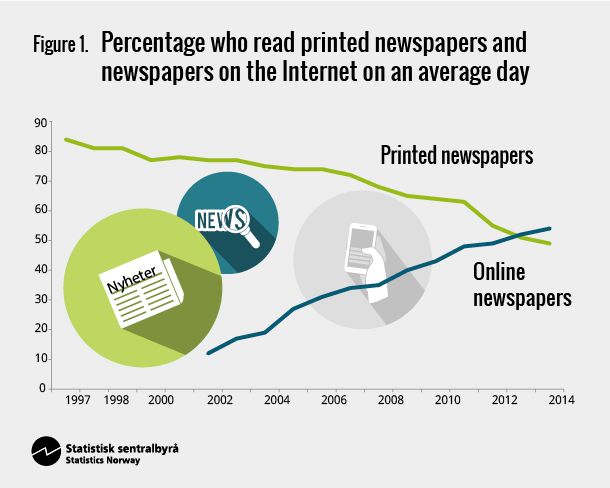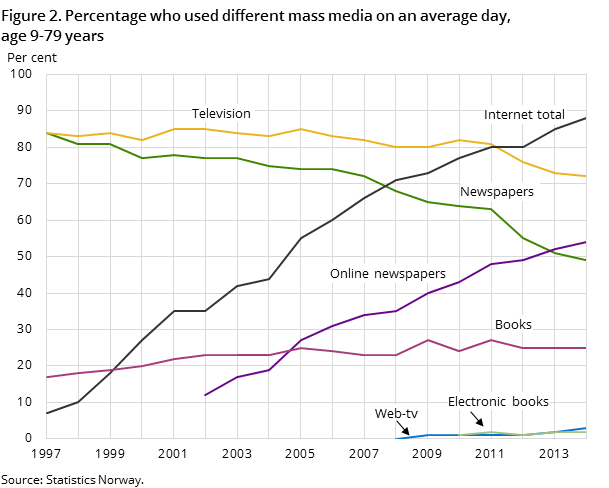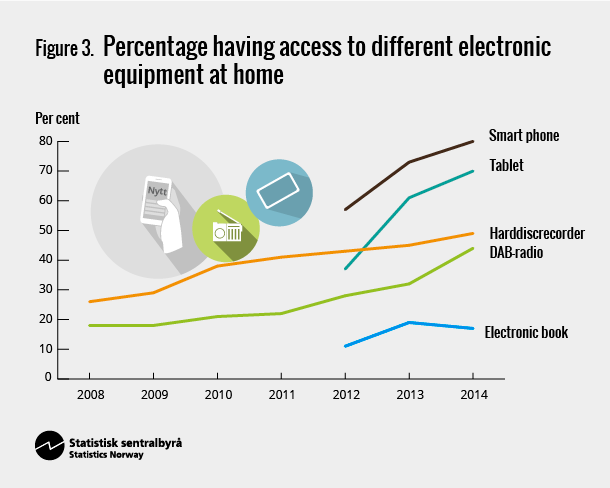Content
Published:
This is an archived release.
Internet issues of newspapers are more popular than printed papers
For the first time, the Norwegian media barometer shows that Internet issues of newspapers are clearly more popular than the printed versions. Streaming services like Netflix are gaining momentum and a growing number of people are using social media.
| 1991 | 2000 | 2013 | 2014 | |
|---|---|---|---|---|
| Newspapers | 84 | 77 | 51 | 49 |
| Television | 81 | 82 | 74 | 74 |
| Radio | 71 | 57 | 59 | 64 |
| Audio media | 43 | 50 | 41 | 39 |
| Weeklies | 21 | 17 | 8 | 8 |
| Books | 24 | 20 | 25 | 25 |
| Magazines | 18 | 14 | 9 | 9 |
| Cartoons | 11 | 9 | 4 | 4 |
| PC | .. | 25 | 75 | 75 |
| Video media | 10 | 10 | 15 | 22 |
| Internet | .. | 27 | 85 | 88 |



The number of persons aged 9-79 reading printed newspapers on an average day saw a small decline from 2013 to 2014. In 2014, 49 per cent of the population read one or more printed newspapers on an average day, compared to 51 per cent in 2013. In 1997, the percentage was 84.
The proportion of people spending time on the Internet per day has grown considerably in recent years. In 2013, the percentage was 85. In 2014, it increased to 88 per cent. The actual time spent on the Internet has also increased; from 112 minutes in 2013 to 120 minutes in 2014. The increase applies only to men but to all age groups, except the youngest ones.
Stable portion of people watching TV over the past two years
The proportion of people watching TV on an average day, i.e. watching transmissions from different channels, has remained fairly stable in recent years, at slightly more than 80 per cent. In the later years there has been a decline, but in 2013 and 2014, the percentage remained stable at 74 per cent. Nevertheless, there has been a decline among children and young persons. Only 3 per cent are watching TV channels via the Internet. Consequently, this is not yet a rival to traditional TV watching (see figure 1).
More people are streaming videos
The portion watching video media per day had previously seen little change. Since 2012, when paid streaming services via the Internet, such as Netflix, were included in the survey, the number of persons watching video media has grown. In 2013, the portion was 15 per cent, increasing to 22 per cent in 2014. As much as 60 per cent of these users were streaming paid video files. Among the age group 16-24 years, the portion was 80 per cent.
More persons are streaming audio files, fewer listen to CDs
Sixty per cent of those who listened to audio media on an average day in 2014 listened to audio files from the Internet. In 2013, the percentage was 55. The proportion using CD players is declining. The percentage listening to audio media on an average day in total was 39 per cent in 2014, compared to 41 per cent in 2013.
Two per cent read electronic books
The percentage of printed book readers on an average day was 17 in 1997. This has subsequently increased. In 2014, it was 25 per cent; the same as the two preceding years. Only 2 per cent read electronic books per day. The share of persons who read weekly publications and cartoon publications on an average day has changed little from 2013 to 2014.
Many use Facebook
Among those who use the Internet during an average day, 64 per cent used Facebook and 22 per cent used other social media. Forty per cent used bank services on the Internet and 75 per cent read the news. Persons aged 16-24 years are the most prevalent Facebook users.
The percentage listening to the radio on an average day has increased during recent years; with 59 per cent in 2013 and 64 per cent in 2014. While 59 per cent listen to traditional radio, 5 per cent listen to the radio channels via the Internet. Nineteen per cent listened to a DAB radio during the day in 2014, compared to 13 per cent in 2013.
44 per cent have a DAB radio
Forty-nine per cent had access to a hard disc recorder in their household in 2014, compared to 45 per cent in 2013 (see table 1). Ninety-six per cent had access to the Internet in the household, the same as the preceding year. Forty-four per cent had a DAB radio in 2014, compared to 32 per cent in 2013. Fifty-four per cent of the population had one or more newspaper subscriptions in their household in 2014. In 2013, the percentage was 58.
For further reading, refer to the Norwegian media barometer for 2014.
Contact
-
Emma Schiro
E-mail: emma.schiro@ssb.no
tel.: (+47) 91 39 78 91
-
Emmie Stolpe Foss
E-mail: emmie.foss@ssb.no
tel.: (+47) 40 81 14 30
-
Elisabeth Haraldsrud
E-mail: elisabeth.haraldsrud@ssb.no
tel.: (+47) 40 81 15 00
